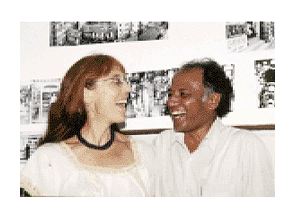The Road to This Project
The path to activism through art is not always direct. We are never sure how to measure our impact. In my work I have chosen to use the vehicle of community history to encourage the empathy and shared understanding that is the groundwork of social change. I have chosen this path because I am committed to the belief that one of the greatest barriers between people is a lack of vision. Unable to imagine what life is like for communities whose circumstances are different from our own, we substitute what we know about ourselves for what we do not know about them.
As a photographer, my goal is to create images that tell the stories of people who live day to day in difficult situations, to be open about their circumstances, but also to pay tribute to the pride and dignity that prevail as they make their way through the complex of arrangements necessary just to keep going. I am interested in survival.
For most of the world the mountain country of Nepal is embodied in IMAX images of the towering beauty of Mt. Everest, the trekking diaries of the winding trails below, and the hard radiance of portraits of the wind-worn ethnic peoples who live tucked away in remote villages. These aspects of Nepal along with the rich temple art of Kathmandu are documented in a strong library of visual images and well-written tales. This is the Nepal that I anticipated when I went to live in Kathmandu for the first six months of the year 2000. This is the Kathmandu of legend, the Nepal of Shangri-La.
The real Kathmandu can be overwhelming. It is a crowded, smoggy city, a ghost of the original idyllic valley clamped tight in the hold of the infamous global economy. Saved from the squalor of the maquiladoras by the absence of a reasonable system of roads (75% of the goods in Nepal are carried on the backs of porters over footpaths), the majority of people in Kathmandu survive in a traditional poverty girded by the caste system and made chronic by endemic corruption in the government, the NGO's and the foreign development agencies. Trying to understand what is going on, how in the world people get through their days in these conditions, became the challenge I faced while living and working in Nepal.
Just as I was about to declare myself over-loaded and temporarily out of the business of documentary projects, I met the Nepali poet Megh Raj Manjul. He came into my life at an art opening where, on a cool February evening, Manjul paid tribute to a feminist exhibition reading a poem he had written about his own mother.  Even though I could not understand the words he was reading, I was fascinated by the feeling of the words. "Ama", "Tika", "Raato." Sloughing off my cultural hesitations, I pushed through the crowd to talk with him.
Even though I could not understand the words he was reading, I was fascinated by the feeling of the words. "Ama", "Tika", "Raato." Sloughing off my cultural hesitations, I pushed through the crowd to talk with him.
Manjul is a master of the art of the immediate. His personality is open and curious. When I showed him a postcard from the exhibition, "We Are All Housekeepers," he did not linger long on the surface, but began to press me for details, for the story of the lineage from slavery to Civil War to the public institutions and labor struggles of today. In turn, he told me his story. Manjul began his career as an itinerant poet working for the democracy struggle in the 1970s and 1980s, singing poems in the remote mountain villages to explain to the people why they needed to support the struggle. He is something of a legend, like Woody Guthrie, especially in a world of illiteracy where song and story are part of the fabric of life.
Since a democratic government was finally installed in 1990, Manjul has seen many hopes destroyed. In an effort to carry this story to the world, he asked me to work with him. I would take photographs of the ordinary people I saw as I walked in the streets of Kathmandu and the surrounding hills. Using these photographs as a source of inspiration, he would write verse in the voice of the people. Together, we would create our version of the untold story of Shangri-La.
By the time I left Nepal in July 2000, Manjul had written more than 50 poems in response to the photographs I had taken. In the intervening year, I have created a series of Composite Digital Images that bring together the people, their stories, and Manjul's poems. All of the images are composed in Photoshop and printed on Archival paper. The original photography was shot with a 35mm. camera on black and white print and color slide film.
I hope that you will join me and Manjul in acknowledging the beauty, the perseverance, and the immensity of life in this remote part of the world.
--Susan Simone
The Photographs and Poems
Wash These Times / Washing Shadows
The Village Inside / Cutting my Dreams
The Tailor's Question / Halembu Girl
The Shopkeeper's Song / The Porter's Song
There's No Way I Can Carry the World
Elephant Feet / The Elephant and The Jungle
Elephant Bath / On Top of the Elephant
The Guestworker / The Roadworkers' Plea
Wash These Times / Washing Shadows
[All poems translated by M. M. Thakur except "Wash These Times," which was translated by Manjul and Susan Simone.]